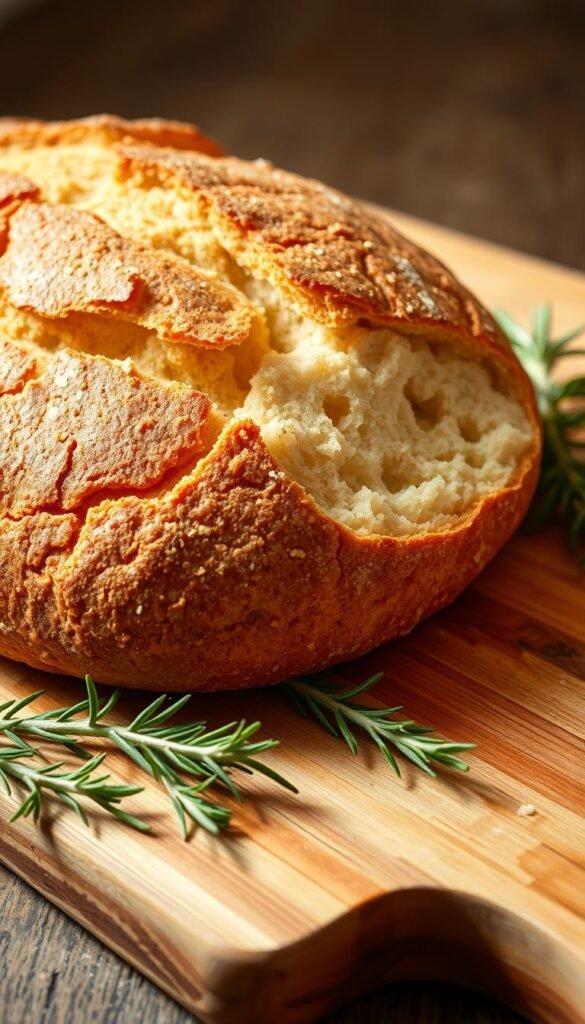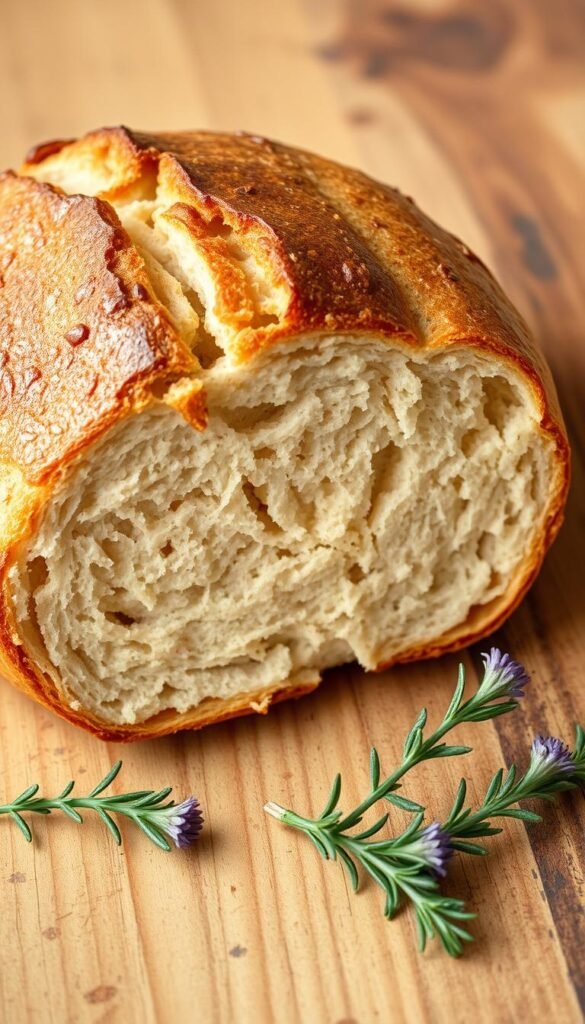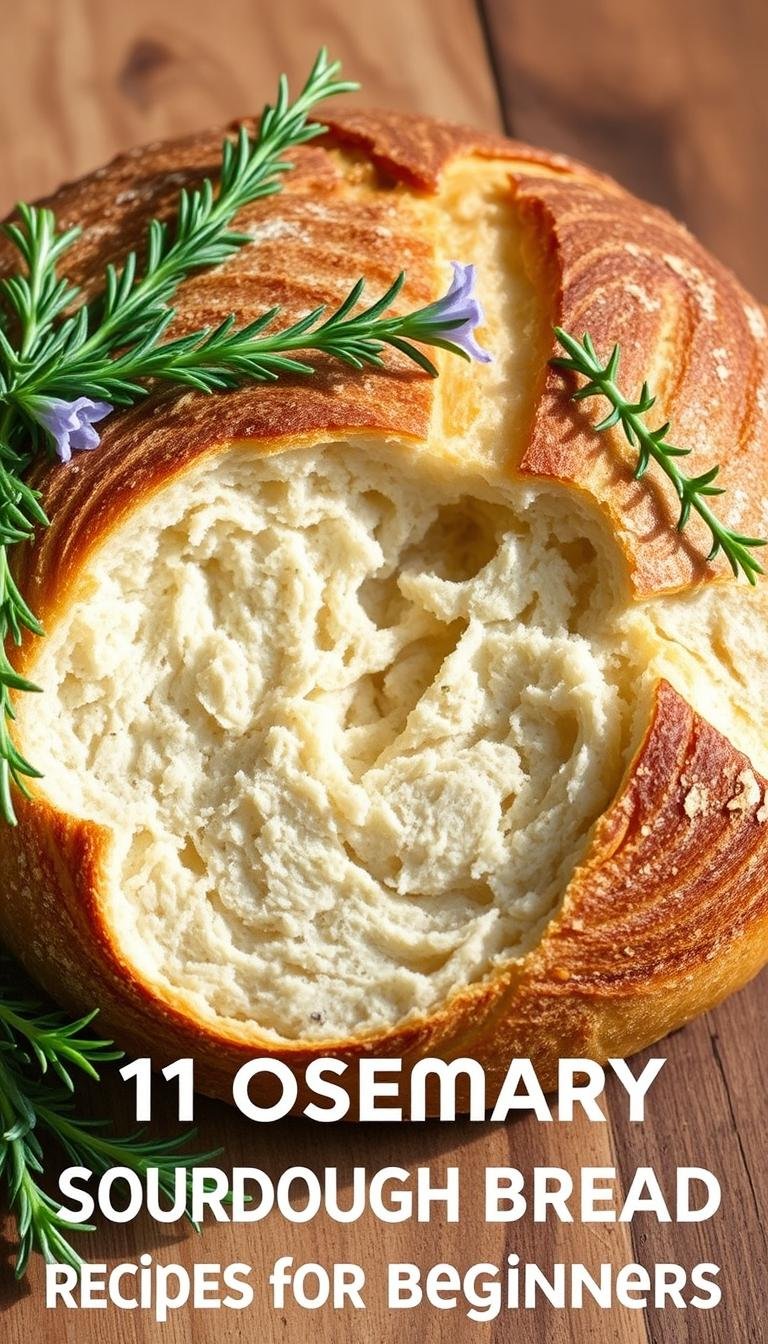11 Easy Rosemary Sourdough Bread Recipes for Beginners
Baking rosemary sourdough bread is becoming more popular. It’s because of the mix of sourdough’s tangy taste and rosemary’s piney flavor. It makes for a special bread experience.
Starting with sourdough baking can seem hard. But, with the right help, anyone can learn it.
These beginner-friendly recipes make it easier. They help new bakers get great results. You can make tasty loaves with rosemary for any event.
Key Takeaways
- Discover the benefits of combining rosemary with sourdough bread.
- Learn how to simplify the sourdough baking process for beginners.
- Explore a variety of homemade bread recipes featuring rosemary.
- Understand the basics of creating a sourdough starter from scratch.
- Find tips for achieving the perfect crust and crumb in your bread.
The Magic of Rosemary Sourdough Bread
Rosemary and sourdough make a perfect pair. They create a tasty and healthy bread. It’s not just about mixing ingredients. It’s about making a meal that tastes great and is good for you.
Why Rosemary and Sourdough Make a Perfect Pair
Rosemary’s piney taste goes well with sourdough’s tangy flavor. Rosemary’s oils mix into the dough during fermentation. This makes the bread taste deeper than regular bread.
Rosemary’s strong flavor stands out in sourdough. It makes the bread smell amazing while it bakes. This makes the bread great for any event, big or small.
Key benefits of combining rosemary and sourdough:
- Enhanced flavor profile
- Aromatic fragrance during baking
- Unique culinary experience
Health Benefits of Homemade Sourdough
Homemade sourdough bread is good for you, especially with rosemary. The way it’s made makes it easier to digest. It also has less sugar and more minerals.
Rosemary is full of antioxidants. These help protect your cells. Adding sourdough’s probiotic benefits makes this bread even healthier. Making your own bread lets you avoid bad ingredients found in store-bought bread.
Nutritional advantages of homemade rosemary sourdough:
- Improved digestibility
- Lower glycemic index
- Increased mineral availability
- Antioxidant properties from rosemary
- Potential probiotic benefits
Essential Sourdough Basics for Beginners
Before you start making rosemary sourdough bread, you need to know the basics. These basics will help you make delicious, crusty loaves. They will impress everyone.
Creating and Maintaining Your Sourdough Starter
Making a sourdough starter from scratch is the first step. You mix flour and water to create a natural yeast culture. Start by mixing 50g of flour with 50g of water in a clean container.
Use a digital scale for precise measurements. This is important for the starter’s health.
Feed your starter often to keep it alive and active. Discard half of the starter and add fresh flour and water. How often you feed it depends on the temperature and the starter’s activity.
A healthy starter should be bubbly, have a tangy aroma, and double in size after feeding.
“A sourdough starter is a natural yeast culture that, when properly maintained, will be the heart of your sourdough baking endeavors.”
Problems with sourdough starters include over-proofing, under-proofing, and contamination. Check the starter’s consistency, smell, and activity level. Adjusting the feeding schedule or environment can often solve these issues.
Essential Equipment for Sourdough Baking
Having the right equipment is key for successful sourdough baking. You’ll need:
- A digital scale for accurate measurements
- A banneton or proofing basket for shaping dough
- A Dutch oven for creating steam during baking
- A bench scraper for handling dough
- A lame or razor blade for scoring the bread
| Equipment | Purpose |
|---|---|
| Digital Scale | Precise ingredient measurement |
| Banneton | Dough proofing and shaping |
| Dutch Oven | Creating steam for crust development |
Don’t buy all the equipment at once. Start with the essentials and add nice-to-have items later.
Understanding Hydration and Fermentation
Hydration and fermentation are key in sourdough baking. Hydration is the water to flour ratio in the dough. It affects the dough’s texture and handling.
Fermentation is when the starter turns sugars into carbon dioxide. This makes the dough rise. Factors like temperature, time, and starter activity level affect fermentation. Monitoring these factors is key to achieving proper fermentation.
To know if fermentation is right, look for bubbles and a domed shape. The dough should smell tangy and feel firm.
Common Mistakes to Avoid in Sourdough Baking
Sourdough baking is fun but can be tricky. Beginners often face problems. But, with the right help, you can avoid these issues.
Starter Problems and Solutions
A healthy sourdough starter is key for great bread. But, it can be hard to keep it right. Issues like insufficient activity, mold contamination, and inconsistent feeding schedules can happen.
To fix starter problems, look for signs like slow fermentation or mold. To solve these, adjust your feeding schedule, check the temperature, and throw away bad parts.
If your starter is slow, add fresh flour and water. For mold, start fresh with a new starter. Keeping a regular feeding schedule helps keep your starter healthy.
Dough Handling Errors
Dough handling is also important in sourdough baking. Mistakes like overworking the dough, insufficient stretching and folding, and improper shaping techniques can happen. Overworking makes the bread dense and tough. Not stretching and folding enough can hurt the bread’s structure.
To fix these, handle the dough gently and only when needed. Do regular stretching and folding to improve the dough’s structure. Also, learn how to shape the dough right. This helps the bread bake evenly. Remember, practice makes perfect, so don’t get discouraged by mistakes.
11 Easy Rosemary Sourdough Bread Recipes for Beginners
Start your sourdough adventure with 11 easy rosemary sourdough bread recipes. These recipes get harder as you go, helping you get better. You’ll try different shapes and flavors, like boules and focaccia.
Each recipe has tips to help you do well. They’re great for beginners. You can learn the basics or try new tastes with these easy sourdough recipes.
| Recipe Type | Complexity Level | Key Ingredients |
|---|---|---|
| Classic Rosemary Sourdough Boule | Easy | Rosemary, Sourdough Starter, Flour |
| No-Knead Rosemary Sourdough | Easy | Rosemary, Sourdough Starter, Water |
| Rosemary and Garlic Sourdough Focaccia | Moderate | Rosemary, Garlic, Olive Oil |
These recipes are tasty and easy for beginners. You’ll get better at making sourdough. You’ll try different breads, from crusty to soft.
1. Classic Rosemary Sourdough Boule
Start a tasty journey with our Classic Rosemary Sourdough Boule recipe. It’s great for both new and experienced bakers. This round boule is filled with rosemary’s scent, making a crunchy loaf.
Ingredients and Equipment
To make this Classic Rosemary Sourdough Boule, you’ll need:
- 1 cup sourdough starter (active and bubbly)
- 3 cups bread flour
- 1 tsp salt
- 2 tbsp olive oil
- 2 sprigs fresh rosemary, chopped
You’ll also need a mixing bowl, dough scraper, and a baking stone or Dutch oven. There are easy alternatives for tools, so everyone can bake.
| Ingredient | Volume | Weight |
|---|---|---|
| Sourdough Starter | 1 cup | 240g |
| Bread Flour | 3 cups | 360g |
| Salt | 1 tsp | 5g |
Step-by-Step Instructions
Here’s how to make your Classic Rosemary Sourdough Boule:
- Mix the dough ingredients, including chopped rosemary, until just combined.
- Knead the dough for 10 minutes until it becomes smooth and elastic.
- Proof the dough for 4-5 hours, or until it has doubled in size.
- Shape the dough into a round boule and let it proof for another 2 hours.
- Bake in a preheated oven at 450°F (230°C) for 25-30 minutes, or until golden brown.
Variations and Customizations
Make your boule special by adding lemon zest or black pepper. These changes can make the rosemary taste even better without making the recipe harder.
Troubleshooting Tips
Issues like rosemary burning or dough spreading too much can happen. To fix these, spread rosemary evenly and watch the dough closely during proofing.
2. No-Knead Rosemary Sourdough
This recipe is great for beginners. It makes delicious bread with less effort. You get to enjoy rosemary and sourdough flavors easily.
Ingredients and Equipment
You’ll need:
- 1 cup sourdough starter (active and bubbly)
- 3 cups bread flour
- 1 cup water
- 1 tsp salt
- 2 tbsp fresh rosemary leaves, chopped
You’ll also need a big bowl, a Dutch oven, and a baking sheet. The Dutch oven is key for a great crust.

Step-by-Step Instructions
Start by mixing the starter, flour, water, salt, and rosemary in a bowl. Just mix until it’s combined. Then, cover it and let it rest for 24 hours.
After resting, do gentle folds every 30 minutes for 2 hours. This helps the dough. Next, put the dough in a basket or a cloth-lined bowl. Let it proof for 4-6 hours.
Preheat your Dutch oven to 450°F (230°C) for 30 minutes. Put the dough in the oven, cover it, and bake for 30 minutes. Then, remove the cover and bake for another 15-20 minutes. The bread will be golden brown.
Variations and Customizations
The no-knead method is very flexible. You can add roasted garlic for more flavor or sun-dried tomatoes for tanginess. These add to the bread’s taste.
Troubleshooting Tips
Issues like wet or dense bread can happen. Make sure your dough is just right during mixing. If it’s too sticky, add flour. If it’s too dry, add water.
Watch the proofing time and temperature. This helps your bread rise perfectly.
3. Rosemary and Garlic Sourdough Focaccia
Try our Rosemary and Garlic Sourdough Focaccia recipe for a taste of Italy. It’s soft and full of flavor. Great with soups or salads.
Ingredients and Equipment
To make this tasty Rosemary and Garlic Sourdough Focaccia, you need:
- 1 cup sourdough starter (active and bubbly)
- 3 cups all-purpose flour
- 1 tsp salt
- 1 tbsp olive oil
- 2 cloves garlic, minced
- 2 sprigs fresh rosemary
- 1 tsp dried rosemary
- A good quality baking sheet or focaccia pan
Focaccia dough has more oil. This makes it soft and tasty.
Step-by-Step Instructions
Mix starter, flour, salt, and oil in a big bowl. Make a shaggy dough. Knead for 10 minutes until smooth.
Put dough in a greased bowl, cover, and warm for 4 hours. It should double in size.
Heat oven to 425°F (220°C). Put dough on a sheet or pan. Dimple it and drizzle with oil. Add garlic and rosemary on top.
Variations and Customizations
Make your Rosemary and Garlic Sourdough Focaccia special. Add cherry tomatoes, olives, or sea salt. They taste great and look good too.
Troubleshooting Tips
If focaccia doesn’t rise, check your starter. If toppings burn, lower oven heat or cover with foil.
4. Rosemary Sourdough Sandwich Bread
Rosemary sourdough sandwich bread is a mix of art and ease. It’s great for those who love sourdough but need something easy to make sandwiches with.
Ingredients and Equipment
To make this bread, you’ll need:
- 1 cup sourdough starter (active and bubbly)
- 3 cups bread flour
- 1 tsp salt
- 1 tbsp sugar
- 1 tbsp olive oil
- 1 tbsp chopped fresh rosemary
- 1 standard loaf pan (9×5 inches)
Essential Equipment: A 9×5 inch loaf pan is key for a perfect sandwich loaf shape.
Step-by-Step Instructions
- Mix starter, flour, salt, sugar, and olive oil in a big bowl. It should be shaggy.
- Knead the dough for 10 minutes until it’s smooth and elastic.
- Put the dough in a greased bowl, cover, and let it rise in a warm place for 4-5 hours, or until it doubles in size.
- Shape the dough into a loaf and put it in the loaf pan.
- Let it rise again for 2-3 hours, or until it’s at the pan’s top.
- Bake at 375°F (190°C) for 35-40 minutes, or until it’s golden brown.
Variations and Customizations
You can make your bread special by adding:
- Dried cranberries for a fruity twist
- Chopped walnuts for added texture
- Garlic for an extra savory flavor
Troubleshooting Tips
Issues like not rising enough and being dense can happen. Make sure your starter is active. And don’t mix the dough too much.
5. Rosemary and Olive Oil Sourdough
Our Rosemary and Olive Oil Sourdough recipe adds a Mediterranean twist. It combines olive oil’s richness with rosemary’s piney taste. This enriched bread dough is great for those wanting to try new sourdough flavors.
Ingredients and Equipment
To make this Mediterranean sourdough, you’ll need:
- 1 cup sourdough starter
- 3 cups bread flour
- 1/4 cup extra virgin olive oil
- 1 tsp salt
- 2 tbsp fresh rosemary, chopped
You’ll also need a mixing bowl, dough scraper, and a baking sheet.
| Ingredient | Quantity |
|---|---|
| Sourdough Starter | 1 cup |
| Bread Flour | 3 cups |
| Olive Oil | 1/4 cup |
Step-by-Step Instructions
Start by mixing the sourdough starter, flour, and water. Add the olive oil slowly and mix well. Knead the dough for 10 minutes, then rest for 4 hours.
Shape the dough and put it on a baking sheet. Let it rise for 2 hours. Preheat your oven to 425°F (220°C). Bake for 25-30 minutes, until it’s golden brown.

Variations and Customizations
To make your olive oil bread recipe even better, try adding:
- Kalamata olives
- Sundried tomatoes
- Roasted red peppers
Troubleshooting Tips
Working with enriched bread dough can take longer. Make sure your dough isn’t overproofed. Adjust baking times to avoid over-browning.
“The addition of olive oil not only enriches the flavor but also affects the texture, making it a perfect base for various Mediterranean-inspired toppings.”
6. Rosemary and Sea Salt Sourdough Crackers
Turn your sourdough discard into tasty rosemary and sea salt crackers. They’re perfect for snacking. This recipe helps use up extra sourdough starter, making a yummy treat.
Ingredients and Equipment
You’ll need sourdough discard, rosemary leaves, sea salt, flour, and olive oil. Use a rolling pin, docker tool or fork, and a baking sheet. It’s a smart way to use up sourdough discard.
Step-by-Step Instructions
Mix the sourdough discard, flour, rosemary, and salt in a bowl. Add olive oil slowly until a dough forms. Roll it out thin with a rolling pin.
Use a docker tool or fork to prick the dough. This stops it from bubbling. Cut into shapes and bake on a sheet. Bake until they’re crispy and golden.
Variations and Customizations
Try different herbs and seasonings instead of rosemary. Garlic powder or dried thyme can be tasty. Add sesame seeds or poppy seeds before baking for extra flavor and texture.
Troubleshooting Tips
If crackers aren’t crispy, they might be underbaked or too thick. Make sure the dough is thin and bake until golden. If they’re too dark, lower the oven temperature or bake for less time.
7. Overnight Rosemary Sourdough
Learn to make tasty rosemary sourdough bread overnight. This time-saving bread method uses cold fermentation. It lets you mix the dough in the evening and bake it fresh in the morning.
Ingredients and Equipment
For this recipe, you’ll need:
- 1 cup sourdough starter
- 3 cups bread flour
- 1 tsp salt
- 2 tbsp rosemary leaves
- 1 tbsp olive oil
Use a container safe for the fridge. You’ll need a bowl, cups, and a baking sheet.
Step-by-Step Instructions
1. Mix the sourdough starter, flour, salt, rosemary, and olive oil in a bowl.
2. Cover the dough and let it rest at room temperature for 10 minutes.
3. Refrigerate the dough overnight (8-12 hours).
4. The next morning, shape the dough and let it proof for 2-3 hours.
5. Bake at 450°F (230°C) for 25-30 minutes.
Variations and Customizations
Change the proofing time to fit your schedule. For more rosemary taste, add more rosemary leaves.
Troubleshooting Tips
Check if the dough has doubled after refrigeration. Adjust baking time based on your oven.
8. Rosemary and Parmesan Sourdough
Make a sourdough bread with rosemary and Parmesan for a tasty twist. It’s great for those who love savory flavors.
Ingredients and Equipment
To make this sourdough, you need:
- 1 cup sourdough starter (active and bubbly)
- 3 cups bread flour
- 1 tsp salt
- 2 tbsp fresh rosemary leaves, chopped
- 1/2 cup grated Parmesan cheese
- 1 tbsp olive oil
You’ll also need a mixing bowl, measuring cups, a wooden spoon or dough whisk, a dough scraper, and a baking sheet or bread stone.
| Ingredient | Measurement |
|---|---|
| Sourdough Starter | 1 cup |
| Bread Flour | 3 cups |
| Salt | 1 tsp |
| Rosemary | 2 tbsp |
| Parmesan Cheese | 1/2 cup |
Step-by-Step Instructions
Mix the starter, flour, salt, rosemary, and Parmesan in a big bowl. Add olive oil and mix until it forms a dough. Knead for 10 minutes until it’s smooth.
Put the dough in a lightly oiled bowl, cover it, and let it rise in a warm place for 4-6 hours. It should double in size.
Preheat your oven to 425°F (220°C). Shape the dough into a round or oblong loaf. Place it on a baking sheet or bread stone. Bake for 35-40 minutes, or until it’s golden brown and sounds hollow when tapped.

Variations and Customizations
Try using Pecorino Romano or Asiago instead of Parmesan for a different taste. Adding garlic or onion can also add flavor.
Troubleshooting Tips
If the dough is too sticky, add a bit more flour. Don’t overmix to avoid a dense bread. If the cheese is burning, cover the top with foil to stop browning.
9. Whole Wheat Rosemary Sourdough
Try making Whole Wheat Rosemary Sourdough for a healthy twist on sourdough. It uses whole wheat flour, rosemary, and sourdough. It’s great for those who care about health.
Ingredients and Equipment
To make Whole Wheat Rosemary Sourdough, you need:
- 1 cup whole wheat flour (white or traditional)
- 1/2 cup bread flour
- 1/2 cup sourdough starter
- 1/2 cup water
- 1 tsp salt
- 2 tbsp chopped fresh rosemary
You’ll need a mixing bowl, measuring cups, a wooden spoon, and a baking sheet or Dutch oven.
| Ingredient | Quantity |
|---|---|
| Whole Wheat Flour | 1 cup |
| Bread Flour | 1/2 cup |
| Sourdough Starter | 1/2 cup |
| Water | 1/2 cup |
| Salt | 1 tsp |
| Fresh Rosemary | 2 tbsp |
Step-by-Step Instructions
Mix whole wheat flour, bread flour, sourdough starter, water, and salt in a bowl. Add chopped rosemary and mix well. Knead the dough for 10 minutes until it’s smooth.
Place the dough in a lightly oiled bowl, cover it, and let it rise in a warm place for 4-5 hours.
Preheat your oven to 450°F (230°C). Shape the dough into a round or oblong loaf. Place it on a baking sheet or in a Dutch oven. Bake for 35-40 minutes, or until it’s golden brown and sounds hollow when tapped.
Variations and Customizations
Customize this recipe by adding oats or barley, or seeds like sesame or sunflower. Try different herbs like thyme or oregano for unique flavors.
Troubleshooting Tips
If your Whole Wheat Rosemary Sourdough is dense, it might be from overmixing or not rising enough. Adjust your mixing and rising times for a lighter texture.
10. Rosemary Sourdough Dinner Rolls
Make your dinner parties special with our Rosemary Sourdough Dinner Rolls. They are tasty and look great. Perfect for holidays or family get-togethers.
Ingredients and Equipment
To make these rolls, you need:
- 1 cup sourdough starter (active and bubbly)
- 2 cups bread flour
- 1/4 cup granulated sugar
- 1/4 cup olive oil
- 1 tsp salt
- 2 tbsp fresh rosemary leaves, chopped
- 1 egg, beaten (for egg wash)
Use a muffin tin or a baking pan to shape and bake the rolls.
Step-by-Step Instructions
Here’s how to make your Rosemary Sourdough Dinner Rolls:
- Mix the dough ingredients, including the sourdough starter, flour, sugar, olive oil, and salt.
- Knead the dough until it becomes smooth and elastic.
- Let the dough rise until doubled in size.
- Divide the dough into equal portions and shape into rolls.
- Place the rolls in the prepared muffin tin or baking pan, leaving space between each roll.
- Brush the tops with beaten egg and sprinkle with chopped rosemary.
- Bake until golden brown.
Variations and Customizations
Try different shapes like knots or crescents. Add melted butter or toppings like sea salt or parmesan cheese.
Troubleshooting Tips
Make sure the rolls are the same size and not too close together. Check them often while baking because they bake faster.
11. Gluten-Free Rosemary Sourdough
Learn to make a tasty gluten-free rosemary sourdough. It’s great for those who need allergen-friendly bread. You can enjoy the flavor of rosemary sourdough without gluten.

Ingredients and Equipment
You’ll need gluten-free flours for this gluten-free sourdough. Use rice flour, potato starch, and tapioca flour. Also, add psyllium husk or xanthan gum for texture. You’ll need sourdough equipment and a gluten-free starter.
- Gluten-free flour blend
- Psyllium husk or xanthan gum
- Rosemary leaves
- Sourdough starter (gluten-free)
- Water
- Salt
Step-by-Step Instructions
Mix the gluten-free flour blend with psyllium husk or xanthan gum, rosemary, starter, water, and salt. The dough will be wet. Let it rest, then shape. Put it in a basket and let it rise. Bake until it’s golden.
Be gentle with the dough and let it proof well for a good rise.
Variations and Customizations
Try different gluten-free flours like almond or coconut flour. Add nuts or seeds for extra flavor and texture.
Troubleshooting Tips
If the bread is gummy, it might be underbaked or have too much xanthan gum. A crumbly texture means it’s overbaked or has too little gum. Adjust these to get the right texture.
Storing and Serving Your Rosemary Sourdough Creations
To keep your rosemary sourdough fresh, follow these tips. Storing it right keeps the bread tasty and soft.
Best Storage Practices
Cool your sourdough completely before storing. This stops moisture from causing mold. Use a bread bag or a breathable box for short storage. Keep it away from sunlight.
For longer storage, refrigerate or freeze your sourdough. Refrigeration adds a few days, while freezing keeps it months. Slice before freezing for easy thawing. Use airtight bags or foil to avoid freezer burn.
Reviving stale bread is easy. Wrap it in foil and warm it in a 300°F oven for a few minutes. The rosemary might make it last longer.
Serving Suggestions and Pairings
Rosemary sourdough is very versatile. Enjoy it with olive oil and balsamic vinegar for a tasty snack. It’s also great with soups and stews, especially those with herbs.
Pair it with roasted meats or as a side to a salad for a bigger meal. Its strong flavor goes well with many cheeses, like brie or goat cheese.
Use leftover sourdough in panzanella or bread pudding for new dishes. Make croutons by cubing the bread, tossing with olive oil, and baking until crispy.
“The discovery of a new dish does more for human happiness than the discovery of a new star.” – Jean Anthelme Brillat-Savarin
Try your rosemary sourdough in different ways. Find your favorite pairings.
Seasonal Variations for Your Rosemary Sourdough
Make your rosemary sourdough special in every season. Change your baking with the seasons. This helps you solve problems and use new ingredients.
Summer and Spring Adaptations
Warmer weather can slow down your dough. Try using less starter, cooler water, or fridge time. Adding lemon zest or fresh herbs is great too. Use edible flowers or citrus for spring and summer vibes.
Fall and Winter Modifications
Cold weather means longer rising times or warmer spots. Keep your starter warm or use a proofing box. Dried fruits, nuts, or spices add warmth in winter. Try festive shapes or toppings for holidays.
Conclusion
You’ve started your journey into rosemary sourdough bread. This mix of rosemary and sourdough is amazing. It makes bread taste better and smell great.
With 11 easy recipes, you’ve learned a lot. You’ve gone from simple to more complex recipes. Now, you’re a rosemary bread master.
There are many types of rosemary sourdough bread. You can make classic loaves or try new things like rosemary and garlic focaccia. There’s even gluten-free bread.
Remember, baking sourdough takes time and effort. But with each loaf, you get better. You’ll enjoy making your own bread more and more.
Don’t forget to share your baking stories. Ask for help and try new things. Keep growing your sourdough baking skills.






